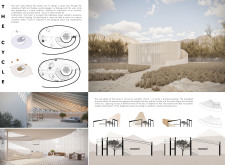5 key facts about this project
The overall concept revolves around the idea of connectivity. The layout encourages movement and collaboration, with open spaces that invite gatherings and facilitate social exchanges. This architectural approach is crucial in today’s urban landscapes, where communal ties often need reinforcement. By establishing a well-connected environment, the project aims to bridge connections among individuals, contributing positively to the social fabric of the area it inhabits.
In terms of functionality, the project is designed to accommodate diverse activities. It includes various spaces such as communal areas, individual stations, and multipurpose rooms, each contributing to the project’s versatility. The careful arrangement of these spaces emphasizes usability while providing the flexibility needed for different events or gatherings throughout the year. This modular aspect enhances its appeal, allowing for changes in function without significant alterations in the structure.
Material selection is pivotal in reinforcing the architectural language of the project. The design prominently features a combination of sustainable materials, including reclaimed wood, glass, and steel. Reclaimed wood is utilized not only for its aesthetic qualities but also for its environmental benefits, reducing the carbon footprint associated with new material production. Glass surfaces are strategically incorporated, allowing natural light to penetrate deeper into the interior spaces—enhancing the ambiance while reducing the reliance on artificial lighting. Steel elements provide the necessary structural support while allowing for expansive open areas.
The project’s unique design elements showcase an innovative approach to integrating natural landscapes with built environments. The use of green roofs and walls exemplifies this commitment to sustainability while enhancing the overall aesthetic appeal. These features not only contribute to the thermal performance of the building but also promote biodiversity, creating habitats for various species and enhancing the surrounding ecosystem.
The architectural language conveys a sense of transparency and openness. Large windows are intentionally positioned to frame views of the outdoor environment, reducing the boundary between the interior and exterior spaces. This design philosophy ensures that occupants are continuously connected with nature, promoting well-being and enhancing the user experience.
Furthermore, the project responds to its geographical context by considering local climate conditions and cultural influences. This consideration influences both the architectural form and material choices, creating a structure that is not only functional but also respectful of its environment. Incorporating traditional local elements into a modern framework allows the design to resonate with the community while reflecting contemporary values.
In analyzing the project’s outcomes, it becomes apparent that the design adeptly achieves its objectives of promoting social interaction, sustainability, and aesthetic coherence. The careful attention to detail—from the choice of materials to the layout of spaces—ensures that the project not only meets the needs of its users but also contributes positively to the broader urban landscape.
Those interested in a more detailed exploration of this architectural project are encouraged to review the architectural plans, sections, and various design elements showcased in the presentation. Delving into the architectural ideas that have shaped this project will provide valuable insights into the thoughtful decisions that define its character.























